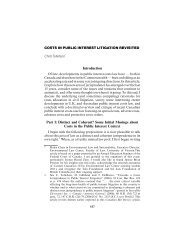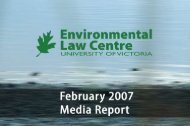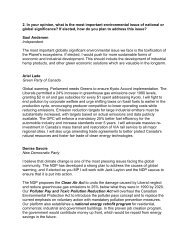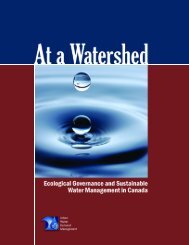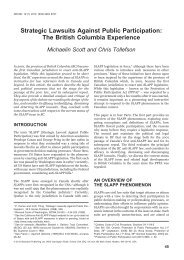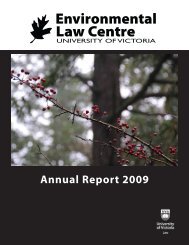Peeling back the Pavement - POLIS Water Sustainability Project
Peeling back the Pavement - POLIS Water Sustainability Project
Peeling back the Pavement - POLIS Water Sustainability Project
You also want an ePaper? Increase the reach of your titles
YUMPU automatically turns print PDFs into web optimized ePapers that Google loves.
PRoblem 1<br />
“CONCRETE JUNGLES”: DESIGN THAT CREATES RUNOFF<br />
New Development and Urban Sprawl<br />
Building cities has always meant replacing <strong>the</strong> natural landscape—forests, wetlands,<br />
and grasslands—with streets, parking lots, rooftops, and o<strong>the</strong>r hard surfaces.<br />
Ra<strong>the</strong>r than designing urban infrastructure to absorb water <strong>the</strong> way nature does,<br />
<strong>the</strong> use of impermeable materials creates <strong>the</strong> problem of runoff. Over <strong>the</strong> past<br />
several decades, <strong>the</strong> proportion of impervious surfaces has increased dramatically<br />
in Canada’s urban areas. Hard surfaces constitute almost half of urban land cover,<br />
and in downtown commercial settings cover up to 96 per cent (with as much as 70<br />
per cent being roof surfaces). 4<br />
The problem of runoff is compounded by <strong>the</strong> zoning decisions and subdivision<br />
design characteristics common in most Canadian communities. Since <strong>the</strong> 1950s,<br />
population growth has been met by developing more land, roads, and water and<br />
sewage treatment infrastructure to meet demand for housing. This has resulted in<br />
urban sprawl across <strong>the</strong> country. When urban sprawl replaces natural landscapes<br />
with impervious surfaces, significant changes in <strong>the</strong> natural patterns of water<br />
movement occur.<br />
1951<br />
1981<br />
2010<br />
Built form - 40 km 2<br />
Built form - 261 km 2<br />
Built form - 469 km 2<br />
City limit - 104 km 2 City limit - 509 km 2<br />
City limit - 848 km 2<br />
Concrete Creates <strong>the</strong> Problem. A supply-side approach to population growth has led to soaring rates<br />
of urban sprawl outside of Calgary, Alberta. This sprawl translates into a loss of natural surfaces and<br />
increased runoff.<br />
Source: City of Calgary<br />
Maintaining Expensive Infrastructure<br />
The Stormwater City drains runoff into a system of pipes where it is conveyed to<br />
streams, lakes, oceans, or o<strong>the</strong>r bodies of water that are often several kilometres<br />
from where <strong>the</strong> rain initially fell. This drainage infrastructure tends to be designed<br />
based on <strong>the</strong> “major flow” of extreme storm events ra<strong>the</strong>r than regular patterns<br />
of precipitation, thus creating an expensive, overbuilt network of infrastructure.<br />
Managing stormwater runoff through hard infrastructure costs Canadian taxpayers<br />
9



